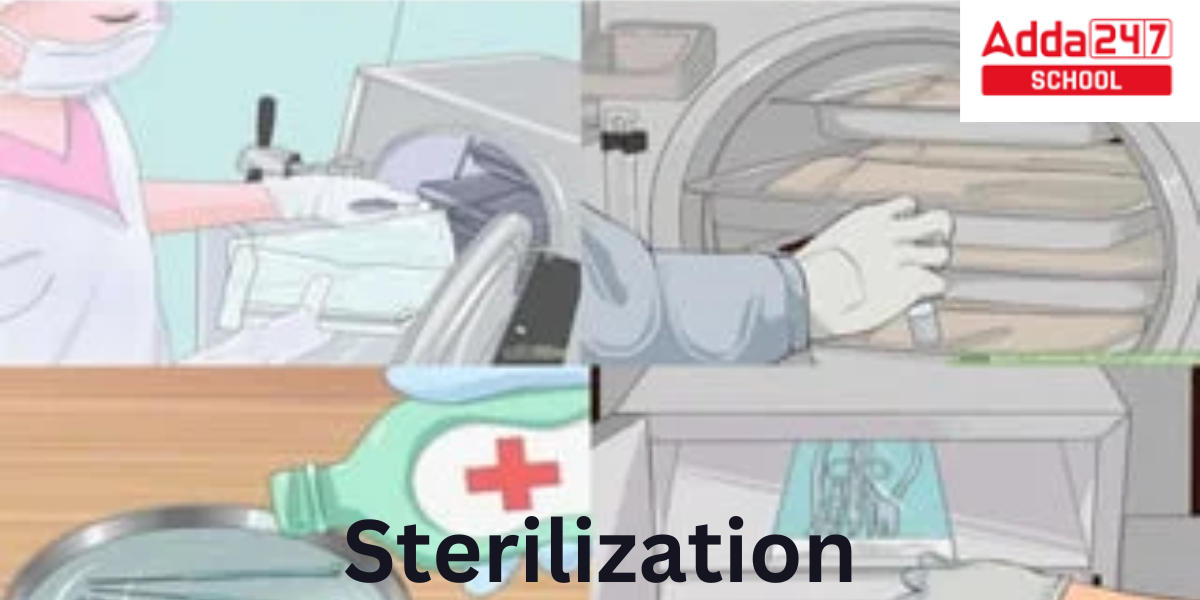Table of Contents
Sterilization Definition
Sterilization is the process of removing all types of bacteria from an object’s surface. It comes in both vegetative and spore forms. Sterilization in microbiology is the total elimination of all germs, including spore and vegetative forms, from a surface or an object. By using a variety of physical and chemical techniques, sterilisation can get rid of about 106 log colony-forming units.
Sterilization is done to prevent the growth of microorganisms that could grow on an object’s surface if the germs were not killed. However, it differs from disinfection or sanitization, which just reduces bacteria rather than completely eliminating them. An item becomes sterile or aseptic after sterilisation.
Sterilization Methods
Following are the methods of Sterilization:
Heat Sterilization
The most efficient type of sterilization is heat sterilization, which gets rid of microorganisms by destroying the enzymes and components of cells. It is done using two techniques:
1. Moist Heat Sterilization:
One of the greatest sterilizing techniques is moist heat sterilization. The technique of moist heat sterilization is carried out with the aid of an autoclave. The idea behind how an autoclave operates is the pressure-driven production of steam. Therefore, steam sterilization is another name for moist heat sterilisation. In an autoclave, the water is brought to a boil at 121–134 °C and 15 psi of pressure. The bacteria is efficiently eliminated as a result of the microorganism’s proteins coagulating.
2. Dry Heat Sterilization:
Dry Heat Sterilization is a technique used to sterilise sensitive-to-moisture items. Dry heat, also known as moisture-free heat, is delivered to a surface or item to cause denaturation and lysis of proteins, which then causes oxidative damage and, ultimately, the death or even burning of the microbiological cell. Incinerators, hot air ovens, and flame processes are a few examples of dry heat sterilising techniques.
Filtration
In microbiology, this is known as a mechanical sterilisation technique. The liquid is filtered out using membranous filters with tiny pores so that no larger particles or bacteria can pass through. Sieving, adsorption, and trapping are the three stages of filtration.
Irradiation
Irradiation is the process of sterilising surfaces or items by exposing them to various radiation types. There are two types:
1. Non-ionizing Radiation:
The object is exposed to ultraviolet radiation, which is taken in by the nucleic acids of the bacteria. Due to the replication mistake caused by the production of pyrimidine dimers in the DNA strand, the microorganism eventually perishes.
2. Ionizing Radiation:
When a microbe is exposed to ionising radiations like X-rays and gamma rays, reactive oxygen species like hydrogen peroxide and superoxide ions are created, which oxidise the bacterium’s biological components and cause its death.
Sound Waves Vibration
Sonix sound waves with a frequency of 20–40 kHz are applied to the fluid that needs to be sterilised. These ultrasonic vibrations cause the solution to develop cavities as compressive and tensile stresses alternate. The abrupt collapse of these cavities results in the formation of microscopic voids and the removal of microorganisms from the container.
Fractional Sterilization
For media containing gelatin or sugar, a technique called fractional sterilisation, also known as tyndallization, is performed. Normally, three days of continuous exposure to 100°C for 20 minutes are needed. According to this theory, all spores and vegetative bacteria are killed at the initial encounter. If they do, the successive exposures will destroy them if they do germinate. The spores of some thermophiles and anaerobes might not be destroyed by this procedure, though.
In microbiology, plastic equipment and biological specimens are sterilised chemically. Several substances operate as bactericidal agents in this technique. They come in two different forms: liquid or gaseous.
Sterilization via Gas
The process known as “gaseous sterilisation” involves exposing the object to gas in a pressurised, heated, and closed chamber. Ethylene oxide, formaldehyde, nitrogen dioxide, and ozone are some of the gaseous chemical agents utilised in sterilisation.
Sterilization with Liquid
The act of immersing an object in a liquid to destroy all living germs and their spores is known as liquid sterilisation. This technique, which is used to get rid of low amounts of contamination, is less efficient than gaseous sterilisation. Hydrogen peroxide, glutaraldehyde, and hypochlorite solutions are common liquid chemicals used for sterilisation.
Sterilization and Disinfection
Sterilization and disinfection are both decontamination techniques. Sterilization is the process of destroying all germs, whereas disinfection is the removal or reduction of hazardous microorganisms from inanimate items and surfaces. The spores of numerous organisms that are found on surfaces, in liquids, in medications, or in substances like biological culture media are also destroyed by sterilisation. Such “severe” decontamination techniques are required during surgical procedures, in industrial settings, in laboratories, and in healthcare facilities. Using disinfection in daily life is more practical.
Chemicals, frequently solutions, but sometimes vapours and gases, are frequently used in the process of disinfection. Chemical sterilants are substances that are employed to eradicate all types of microbiologic life. The same germicides that are used for shorter exposure times might also be employed throughout the cleaning procedure (i.e. high-level disinfection).


 AILET Admit Card 2025 Out, Get Direct Do...
AILET Admit Card 2025 Out, Get Direct Do...
 Best Books for NEET by Toppers 2025, Get...
Best Books for NEET by Toppers 2025, Get...
 Assam HSLC Routine 2025 OUT, Check SEBA ...
Assam HSLC Routine 2025 OUT, Check SEBA ...































